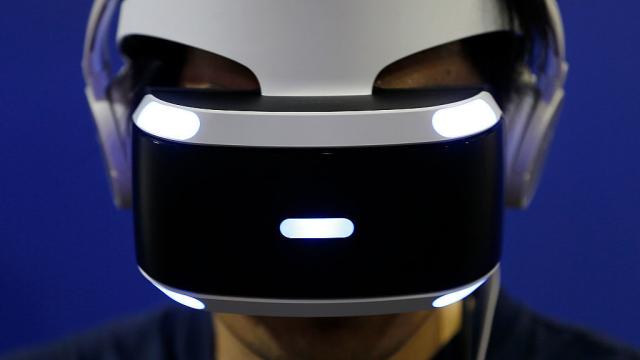Getting a virtual reality headset might make for a pretty impressive christmas present, but unless you’ve got enough computing power to use the thing, consider it a very expensive paperweight. Depending on the system powering your headset, either a PC or a PS4, here’s how to get it prepped and ready for virtual reality.
Image credit: Yuya Shino/Getty
Got a PS4? Buy a PlayStation VR Bundle
Every PlayStation 4 supports virtual reality, with the PlayStation 4 Pro offering a slightly better visual experience thanks to its more powerful internal components. Of course, they only support virtual reality through Sony’s own PlayStation VR headset. You’ll need to buy the right version, however, or else you’ll be missing a very key component.
If you’ve got any PlayStation 4 console, whether it’s the original PlayStation 4, its updated, slimmer version, or the more powerful PlayStation 4 Pro, you’ll be able to use the PlayStation VR headset. You’ll also need one extra hardware component, the PlayStation Camera, to track the headset and your movements.
If you want to get everything you need in one go, purchase a PlayStation VR bundle, which includes a PlayStation Camera along with the rest of the VR headset components. Certain bundles also include PlayStation Move motion controllers, which replace your traditional DualShock 4 controller.
Got a PC? You Might Need New Hardware
Unlike PlayStation VR, using virtual reality on your PC might require more than buying a headset bundle. Your PC should meet the minimum specifications of your virtual reality headset, whether it’s an Oculus Rift or HTC Vive.
You can run benchmark tests on your PC to see if yours is VR-ready. The recommended specifications for each headset listed below might be more than you bargained for if you don’t feel like doing any upgrading:
Oculus Rift Recommended Requirements
Graphics Card: NVIDIA GTX 1060 / AMD Radeon RX 480 or greater
Alternative Graphics Card: NVIDIA GTX 970 / AMD Radeon R9 290 or greater
CPU: Intel i5-4590 / AMD Ryzen 5 1500X or greater
Memory: 8GB+ RAM
Video Output: Compatible HDMI 1.3 video output
USB Ports: 3x USB 3.0 ports, plus 1x USB 2.0 port
OS: Windows 7 SP1 64 bit or newer
HTC Vive Recommended Requirements
Graphics Card: NVIDIA GeForce GTX 1060 or AMD Radeon RX 480, equivalent or better
CPU: Intel Core i5-4590 or AMD FX™ 8350, equivalent or better
Memory: 4GB RAM or more
Video Output: 1x HDMI 1.4 port, or DisplayPort 1.2 or newer
USB Ports: 1x USB 2.0 port or newer
OS: Windows 7 SP1 or later
That means you might have to swap some parts out of your PC, whether its RAM or a new graphics card. As long as you’re comfortable actually pulling parts out of your PC, go for it. If not, you can always bite the bullet and replace your old PC with VR-capable machines sold expressly for VR headsets.
You can buy computers labelled “VR ready” wherever you’re shopping. You can expect to pay around $1000 for a low-end PC that can handle VR, so maybe consider upgrading your own PC first.
Once you’ve got yourself the right hardware, you’ll need one more thing: actual space. Follow the instructions on positioning the tracking cameras that came with the HTC Vive or Oculus Rift, ensure you’re not going to swing your arms into any dangerous or sharp objects and enjoy.

Comments